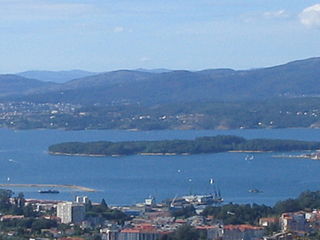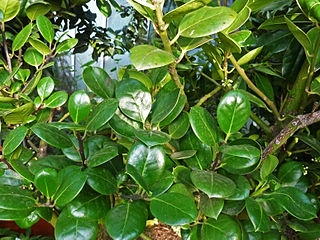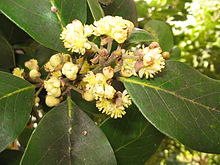
Laurus nobilis is an aromatic evergreen tree or large shrub with green, glabrous (smooth) leaves. It is in the flowering plant family Lauraceae. It is native to the Mediterranean region and is used as bay leaf for seasoning in cooking. Its common names include bay tree, bay laurel, sweet bay, true laurel, Grecian laurel, or simply laurel. Laurus nobilis figures prominently in classical Greco-Roman culture.

Bolle's pigeon, Bolle's laurel pigeon or dark-tailed laurel pigeon is a species of the genus Columba of family Columbidae, doves and pigeons, endemic to the Canary Islands, Spain. This bird is named after the German naturalist Carl Bolle, who was the first to distinguish it from the laurel pigeon. This wood pigeon is endemic to the laurel forest habitat.

Persea is a genus of about 150 species of evergreen trees belonging to the laurel family, Lauraceae. The best-known member of the genus is the avocado, P. americana, widely cultivated in subtropical regions for its large, edible fruit.

Laurel forest, also called laurisilva or laurissilva, is a type of subtropical forest found in areas with high humidity and relatively stable, mild temperatures. The forest is characterized by broadleaf tree species with evergreen, glossy and elongated leaves, known as "laurophyll" or "lauroid". Plants from the laurel family (Lauraceae) may or may not be present, depending on the location.

Laurus is a genus of evergreen trees or shrubs belonging to the laurel family, Lauraceae. The genus contains three or more species, including the bay laurel or sweet bay, L. nobilis, widely cultivated as an ornamental plant and a culinary herb.

Garajonay National Park is located in the center and north of the island of La Gomera, one of the Canary Islands (Spain). It was declared a national park in 1981 and a World Heritage Site by UNESCO in 1986. It occupies 40 km2 and it extends into each of the six municipalities on the island.

Picconia is a genus of two species of flowering plants in the family Oleaceae, found in the laurel forests habitat of Macaronesia.

Juniperus brevifolia, the Azores juniper, is a species of juniper, endemic to the Azores, where it occurs at altitudes of 240–800 metres, rarely up to 1,500 m (4,900 ft). It is closely related to Juniperus oxycedrus of the Mediterranean region and Juniperus cedrus of the neighboring Macaronesian islands. It is threatened by habitat loss.

Prunus lusitanica, the Portuguese laurel cherry or Portugal laurel, is a species of flowering plant in the rose family Rosaceae, native to the Iberian Peninsula, Morocco, the Macaronesian archipelagos, and the French Basque Country.

Cortegada is an almost tidal island in a coastal inlet near Pontevedra in Galicia, Spain. It is part of the Atlantic Islands of Galicia National Park.

Ocotea foetens, commonly called til or stinkwood is a species of tree in the family Lauraceae. It is evergreen and grows up to 40 m tall. It is a common constituent of the laurisilva forests of Madeira and the Canary Islands. Leaf fossils of this species are known from the Mio-Pleistocene of Madeira Island.

Picconia azorica, locally known as pau-branco, is a species of Picconia common to the majority of islands of the Portuguese archipelago of the Azores, where it is endemic. It can grow to a medium-sized tree, though it is usually found in the form of a shrub. It is threatened by habitat loss.
Pico da Vara is the highest mountain on the island of São Miguel, in the Portuguese archipelago of the Azores, and principal special protection of the Nature Reserve of Pico da Vara. The area around the mountain includes the largest remaining stand of the native laurisilva forest on the island, home to the critically endangered endemic Azores bullfinch.

Laurus novocanariensis is a large shrub or tree with aromatic, shiny dark-green foliage. belonging to the evergreen tree genus Laurus of the laurel family, Lauraceae. The genus includes three species, whose diagnostic key characters often overlap. Under favorable conditions it is an impressive tree of 3 to 20 m. tall. It is native of rich soils in the cloud zone of always moist spots in subtropical climate with a high air-humidity, on the Canary and Madeira islands.

The Azores temperate mixed forests is a temperate broadleaf and mixed forests ecoregion of southwestern Europe. It encompasses the Azores archipelago in the Atlantic Ocean. These volcanic islands are an autonomous region of Portugal, and lie 1500 km west of the Portuguese mainland.

Ilex perado, the Macaronesian holly, is a species of holly endemic to Macaronesia, distributed throughout the Azores, Madeira and Canary islands. It is an important component of the natural high-altitude Macaronesian rainforest, known as 'laurisilva', found mostly at 500 to 1,200 m altitude but it also appears in forest formations at lower elevation. Many of the subspecies have been classified as threatened, probably because of very small population sizes, and are protected by local, national and regional legislation.

Viburnum treleasei, the Azorean laurustinus, is a species in the genus Viburnum endemic to the Azores. It inhabits natural forests of Juniperus brevifolia, Laurus azorica and Ilex perado, Erica azorica, in sloping areas. Generally at altitudes above 200 m (660 ft). It is present in eight of the nine islands.
Maytenus umbellata is a species of plant in the family Celastraceae. Common names include Buxo-da-rocha and Madeira shrubby bittersweet. It is endemic to Madeira.

Trechus terrabravensis is a beetle species in the family Carabidae endemic to Terceira Island, Azores, Portugal.
Crotchiella is a genus of longhorn beetles containing only one species, Crotchiella brachyptera, an endangered species endemic to the Azores.




















